2006 SUBARU TRIBECA light
[x] Cancel search: lightPage 222 of 377
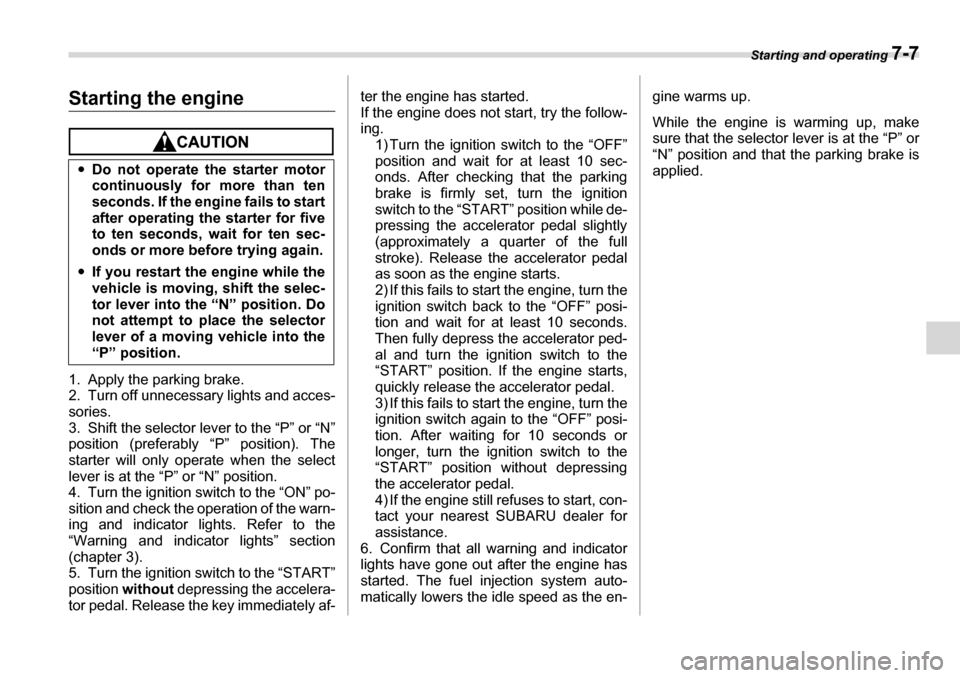
Starting and operating 7-7
Starting the engine
1. Apply the parking brake.
2. Turn off unnecessary lights and acces- sories.
3. Shift the selector lever to the “P” or “N”
position (preferably “P” position). The
starter will only operate when the select
lever is at the “P” or “N” position.
4. Turn the ignition switch to the “ON” po-
sition and check the operation of the warn-
ing and indicator lights. Refer to the
“Warning and indicator lights” section
(chapter 3).
5. Turn the ignition switch to the “START”position without depressing the accelera-
tor pedal. Release the key immediately af- ter the engine has started.
If the engine does not start, try the follow-
ing.
1) Turn the ignition switch to the “OFF”
position and wait for at least 10 sec-
onds. After checking that the parking
brake is firmly set, turn the ignition
switch to the “START” position while de-
pressing the accelerator pedal slightly(approximately a quarter of the full
stroke). Release the accelerator pedal
as soon as the engine starts.
2) If this fails to start the engine, turn the
ignition switch back to the “OFF” posi-
tion and wait for at least 10 seconds.
Then fully depress the accelerator ped-
al and turn the ignition switch to the
“START” position. If the engine starts,
quickly release the accelerator pedal.
3) If this fails to start the engine, turn the
ignition switch again to the “OFF” posi-
tion. After waiting for 10 seconds or
longer, turn the ignition switch to the
“START” position without depressing
the accelerator pedal.
4) If the engine still refuses to start, con-
tact your nearest SUBARU dealer for
assistance.
6. Confirm that all warning and indicator
lights have gone out after the engine has
started. The fuel injection system auto-
matically lowers the idle speed as the en- gine warms up.
While the engine is warming up, make
sure that the selector lever is at the “P” or
“N” position and that the parking brake is
applied.
�y
Do not operate the starter motor
continuously for more than ten
seconds. If the engine fails to start
after operating the starter for five
to ten seconds, wait for ten sec-
onds or more before trying again.
�y If you restart the engine while the
vehicle is moving, shift the selec-
tor lever into the “N” position. Do
not attempt to place the selector
lever of a moving vehicle into the “P” position.
Page 224 of 377
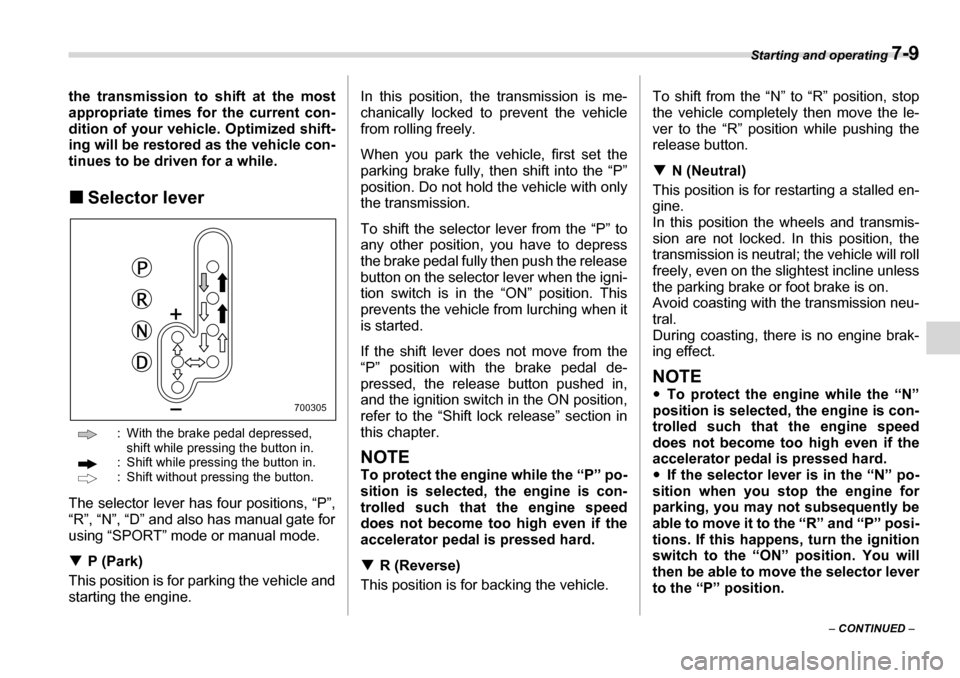
Starting and operating 7-9
– CONTINUED –
the transmission to shift at the most
appropriate times for the current con-
dition of your vehicle. Optimized shift-
ing will be restored as the vehicle con-
tinues to be driven for a while. �„
Selector lever
: With the brake pedal depressed, shift while pressing the button in.
: Shift while pressing the button in.
: Shift without pressing the button.
The selector lever has four positions, “P”,
“R”, “N”, “D” and also has manual gate for
using “SPORT” mode or manual mode. �T P (Park)
This position is for parking the vehicle and
starting the engine. In this position, the transmission is me-
chanically locked to prevent the vehicle
from rolling freely.
When you park the vehicle, first set the
parking brake fully, then shift into the “P”
position. Do not hold the vehicle with onlythe transmission.
To shift the selector lever from the “P” to
any other position, you have to depress
the brake pedal fully then push the release
button on the selector lever when the igni-
tion switch is in the “ON” position. This
prevents the vehicle from lurching when it
is started.
If the shift lever does not move from the
“P” position with the brake pedal de-
pressed, the release button pushed in,
and the ignition switch in the ON position,
refer to the “Shift lock release” section in
this chapter.
NOTE
To protect the engine while the “P” po-
sition is selected, the engine is con-
trolled such that the engine speed
does not become too high even if the
accelerator pedal is pressed hard. �T
R (Reverse)
This position is for backing the vehicle. To shift from the “N” to “R” position, stop
the vehicle completely then move the le-
ver to the “R” position while pushing the
release button. �T
N (Neutral)
This position is for restarting a stalled en-
gine.
In this position the wheels and transmis-
sion are not locked. In this position, the
transmission is neutral; the vehicle will roll
freely, even on the slightest incline unless
the parking brake or foot brake is on.
Avoid coasting with the transmission neu-tral.
During coasting, there is no engine brak-
ing effect.
NOTE �y To protect the engine while the “N”
position is selected, the engine is con-
trolled such that the engine speed
does not become too high even if the
accelerator pedal is pressed hard.�y If the selector lever is in the “N” po-
sition when you stop the engine for
parking, you may not subsequently be
able to move it to the “R” and “P” posi-
tions. If this happens, turn the ignition
switch to the “ON” position. You will
then be able to move the selector lever
to the “P” position.
700305
Page 227 of 377

7-12 Starting and operating
Gearshifts can be performed using the se-
lector lever.
Shift to the next-higher gear by briefly
pushing the selector lever toward the “+”
end of the manual gate.
Shift to the next-lower gear by briefly pull-
ing the selector lever toward the “–” end of
the manual gate.
NOTE
Please read the following points care-
fully and bear them in mind when usingthe manual mode. �yWhen the temperature of the engine
oil is higher than normal, warning
beeps are emitted and the shift posi-
tion indicator shows “–”. If these warn-
ings are issued, deselect the manual
mode to protect the engine from dam- age. �y
The transmission does not automati-
cally shift up in the manual mode. Per-
form gearshifts in accordance with
road conditions so that the tachometer
needle does not enter the red zone. If
the engine speed reaches a predeter-
mined level, a fuel-cut function will op-
erate. Shift up if this happens. Also, the
transmission may automatically shift
up to protect the engine. �y If you attempt to shift down when the
engine speed is too high, i.e., when a
downshift would push the tachometer
needle beyond the red zone, beeps will
be emitted to warn you that the down-
shift is not possible. �y If you attempt to shift up when the
vehicle speed is too low, the transmis-
sion will not respond. �y You can perform a skip-shift (for ex-
ample, from 4th to 2nd) by operating
the selector lever twice in rapid suc-
cession. �y The transmission automatically se-
lects 1st gear when the vehicle stops
moving. �y If the temperature of the automatic
transmission fluid becomes too high,
the “AT OIL TEMP” warning light will
come on and upshifts to 5th gear will
not be possible. Immediately stop the vehicle in a safe place and let the en-
gine idle until the warning light goes off.
�„ Maximum speeds
The following tables show the maximum
speeds that are possible with each differ- ent gear.
When down shifting, it is important to con-
firm that the current vehicle speed is not in
excess of the Maximum Allowable Speed
700309
When down shifting, ensure that the
vehicle is not travelling at a speed
exceeding the Maximum Allowable
Speed for the gear which is about to
be selected. Failure to observe this
precaution can lead to engine over-
revving and this in turn can result in
engine damage.
In addition, sudden application of
engine braking caused by down
shifting when the vehicle is travel-
ling on a slippery surface can lead to
wheel locking; as a consequence,
control of the vehicle may be lost
and the risk of an accident in-
creased.
Page 228 of 377
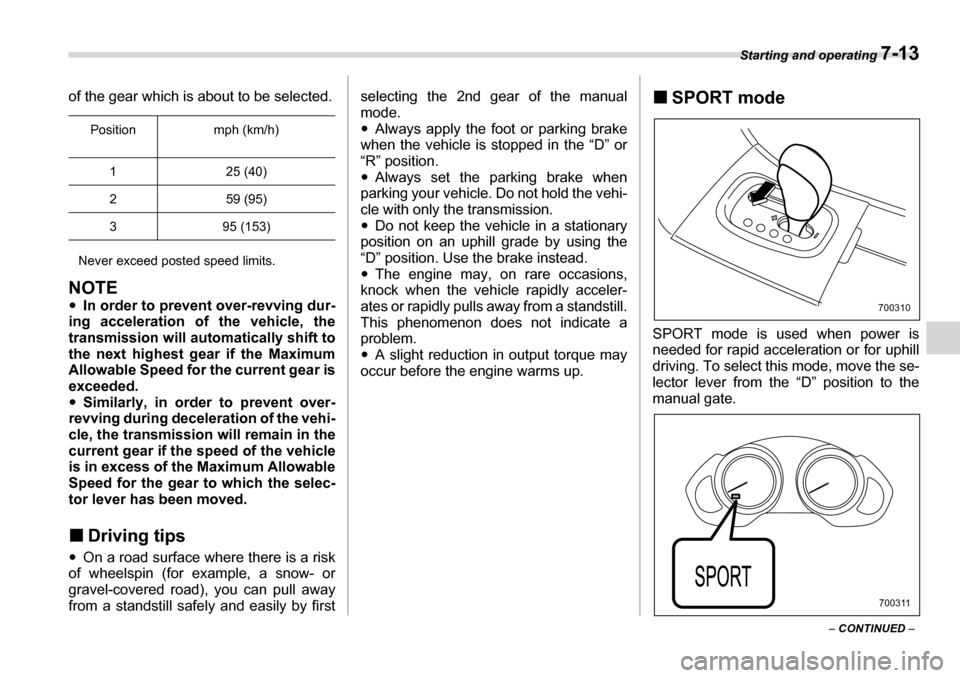
Starting and operating 7-13
– CONTINUED –
of the gear which is about to be selected.
Never exceed posted speed limits.
NOTE �y In order to prevent over-revving dur-
ing acceleration of the vehicle, the
transmission will automatically shift to
the next highest gear if the Maximum
Allowable Speed for the current gear is
exceeded.�y Similarly, in order to prevent over-
revving during deceleration of the vehi-
cle, the transmission will remain in the
current gear if the speed of the vehicle
is in excess of the Maximum Allowable
Speed for the gear to which the selec-
tor lever has been moved. �„ Driving tips
�y On a road surface where there is a risk
of wheelspin (for example, a snow- or
gravel-covered road), you can pull away
from a standstill safely and easily by first selecting the 2nd gear of the manual mode. �y
Always apply the foot or parking brake
when the vehicle is stopped in the “D” or
“R” position. �y Always set the parking brake when
parking your vehicle. Do not hold the vehi-
cle with only the transmission. �y Do not keep the vehicle in a stationary
position on an uphill grade by using the
“D” position. Use the brake instead. �y The engine may, on rare occasions,
knock when the vehicle rapidly acceler-
ates or rapidly pulls away from a standstill.
This phenomenon does not indicate a
problem. �y A slight reduction in output torque may
occur before the engine warms up. �„
SPORT mode
SPORT mode is used when power is
needed for rapid acceleration or for uphill
driving. To select this mode, move the se-
lector lever from the “D” position to the
manual gate.
Position mph (km/h)
1 25 (40)
2 59 (95)
3 95 (153)
700310
700311
Page 229 of 377
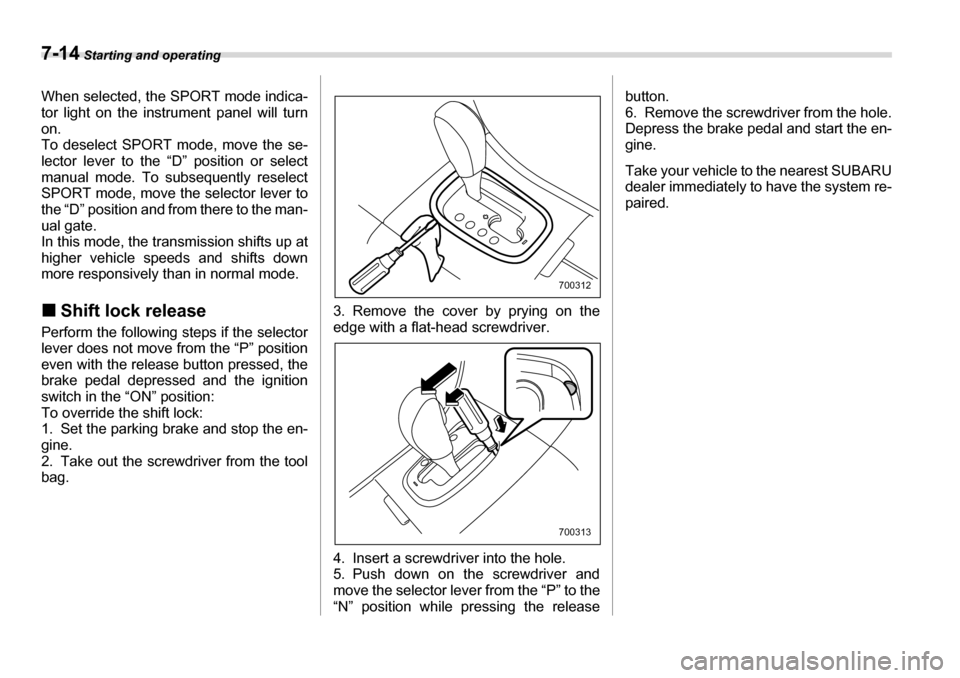
7-14 Starting and operating
When selected, the SPORT mode indica-
tor light on the instrument panel will turn
on.
To deselect SPORT mode, move the se-
lector lever to the “D” position or select
manual mode. To subsequently reselect
SPORT mode, move the selector lever to
the “D” position and from there to the man-
ual gate.
In this mode, the transmission shifts up at
higher vehicle speeds and shifts down
more responsively than in normal mode. �„Shift lock release
Perform the following steps if the selector
lever does not move from the “P” position
even with the release button pressed, the
brake pedal depressed and the ignition
switch in the “ON” position:
To override the shift lock:
1. Set the parking brake and stop the en-
gine.
2. Take out the screwdriver from the tool
bag. 3. Remove the cover by prying on the
edge with a flat-head screwdriver.
4. Insert a screwdriver into the hole.
5. Push down on the screwdriver and
move the selector lever from the “P” to the
“N” position while pressing the release button.
6. Remove the screwdriver from the hole.
Depress the brake pedal and start the en-
gine.
Take your vehicle to the nearest SUBARU
dealer immediately to have the system re-
paired.
700312
700313
Page 230 of 377
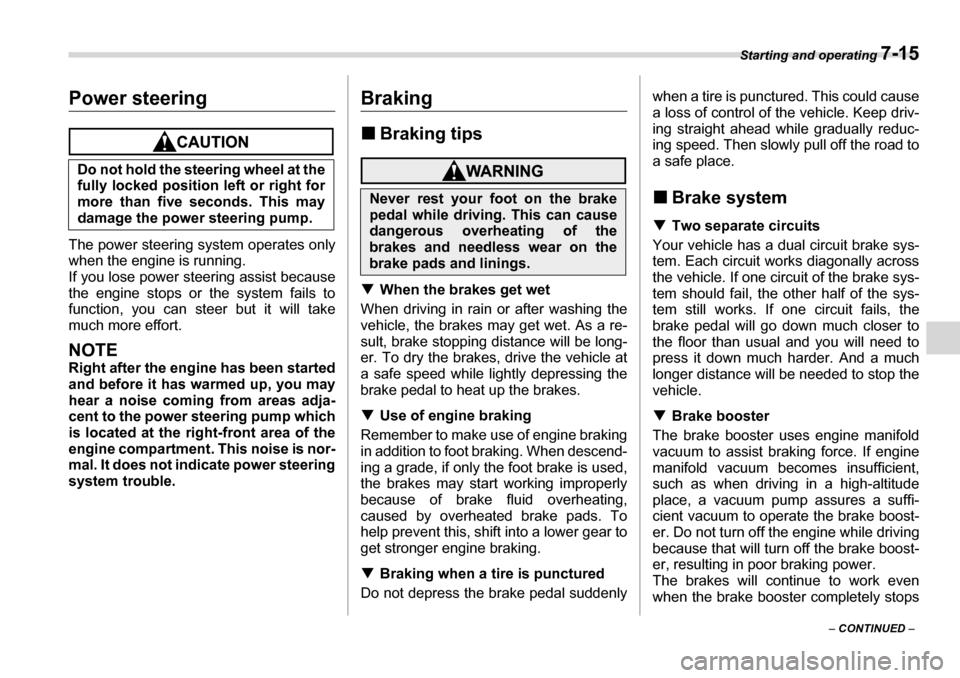
Starting and operating 7-15
– CONTINUED –
Power steering
The power steering system operates only
when the engine is running.
If you lose power steering assist because
the engine stops or the system fails to
function, you can steer but it will take
much more effort.
NOTE
Right after the engine has been started
and before it has warmed up, you may
hear a noise coming from areas adja-
cent to the power steering pump whichis located at the right-front area of the
engine compartment. This noise is nor-
mal. It does not indicate power steering
system trouble.
Braking �„Braking tips
�TWhen the brakes get wet
When driving in rain or after washing the
vehicle, the brakes may get wet. As a re-
sult, brake stopping distance will be long-
er. To dry the brakes, drive the vehicle at
a safe speed while lightly depressing the
brake pedal to heat up the brakes. �T Use of engine braking
Remember to make use of engine braking
in addition to foot braking. When descend-
ing a grade, if only the foot brake is used,
the brakes may start working improperly
because of brake fluid overheating,
caused by overheated brake pads. To
help prevent this, shift into a lower gear to
get stronger engine braking. �T Braking when a tire is punctured
Do not depress the brake pedal suddenly when a tire is punctured. This could cause
a loss of control of the vehicle. Keep driv-
ing straight ahead while gradually reduc-
ing speed. Then slowly pull off the road to
a safe place. �„
Brake system
�T Two separate circuits
Your vehicle has a dual circuit brake sys-
tem. Each circuit works diagonally across
the vehicle. If one circuit of the brake sys-
tem should fail, the other half of the sys-
tem still works. If one circuit fails, the
brake pedal will go down much closer to
the floor than usual and you will need to
press it down much harder. And a much
longer distance will be needed to stop the vehicle. �T Brake booster
The brake booster uses engine manifold
vacuum to assist braking force. If engine
manifold vacuum becomes insufficient,
such as when driving in a high-altitude
place, a vacuum pump assures a suffi-
cient vacuum to operate the brake boost-
er. Do not turn off the engine while driving
because that will turn off the brake boost-
er, resulting in poor braking power.
The brakes will continue to work even
when the brake booster completely stops
Do not hold the steering wheel at the
fully locked position left or right for
more than five seconds. This may
damage the power steering pump.
Never rest your foot on the brake
pedal while driving. This can cause
dangerous overheating of the
brakes and needless wear on the
brake pads and linings.
Page 232 of 377
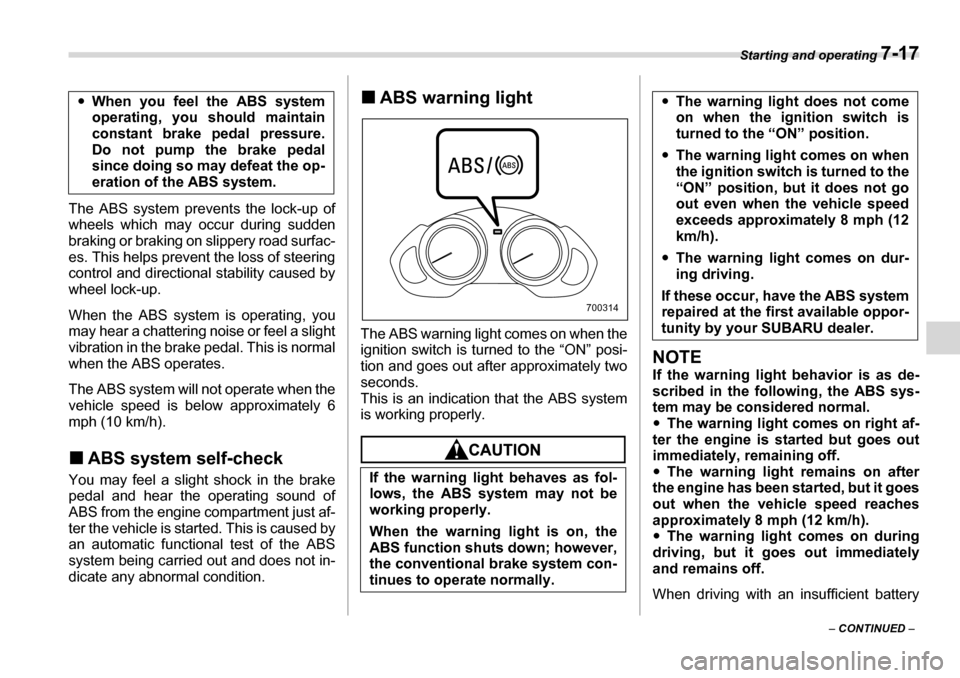
Starting and operating 7-17
– CONTINUED –
The ABS system prevents the lock-up of
wheels which may occur during sudden
braking or braking on slippery road surfac-
es. This helps prevent the loss of steering
control and directional stability caused by
wheel lock-up.
When the ABS system is operating, you
may hear a chattering noise or feel a slight
vibration in the brake pedal. This is normal
when the ABS operates.
The ABS system will not operate when the
vehicle speed is below approximately 6
mph (10 km/h). �„
ABS system self-check
You may feel a slight shock in the brake
pedal and hear the operating sound ofABS from the engine compartment just af-
ter the vehicle is started. This is caused by
an automatic functional test of the ABS
system being carried out and does not in-
dicate any abnormal condition. �„
ABS warning light
The ABS warning light comes on when the
ignition switch is turned to the “ON” posi-
tion and goes out after approximately twoseconds.
This is an indication that the ABS system
is working properly.
NOTE
If the warning light behavior is as de-
scribed in the following, the ABS sys-
tem may be considered normal. �y The warning light comes on right af-
ter the engine is started but goes out
immediately, remaining off. �y The warning light remains on after
the engine has been started, but it goes
out when the vehicle speed reaches
approximately 8 mph (12 km/h). �y The warning light comes on during
driving, but it goes out immediately
and remains off.
When driving with an insufficient battery
�y
When you feel the ABS system
operating, you should maintain
constant brake pedal pressure.
Do not pump the brake pedal
since doing so may defeat the op-
eration of the ABS system.
If the warning light behaves as fol-
lows, the ABS system may not be
working properly.
When the warning light is on, the
ABS function shuts down; however,
the conventional brake system con-
tinues to operate normally.
700314
�yThe warning light does not come
on when the ignition switch is
turned to the “ON” position.
�y The warning light comes on when
the ignition switch is turned to the
“ON” position, but it does not go
out even when the vehicle speed
exceeds approximately 8 mph (12 km/h).
�y The warning light comes on dur-
ing driving.
If these occur, have the ABS system
repaired at the first available oppor-
tunity by your SUBARU dealer.
Page 233 of 377
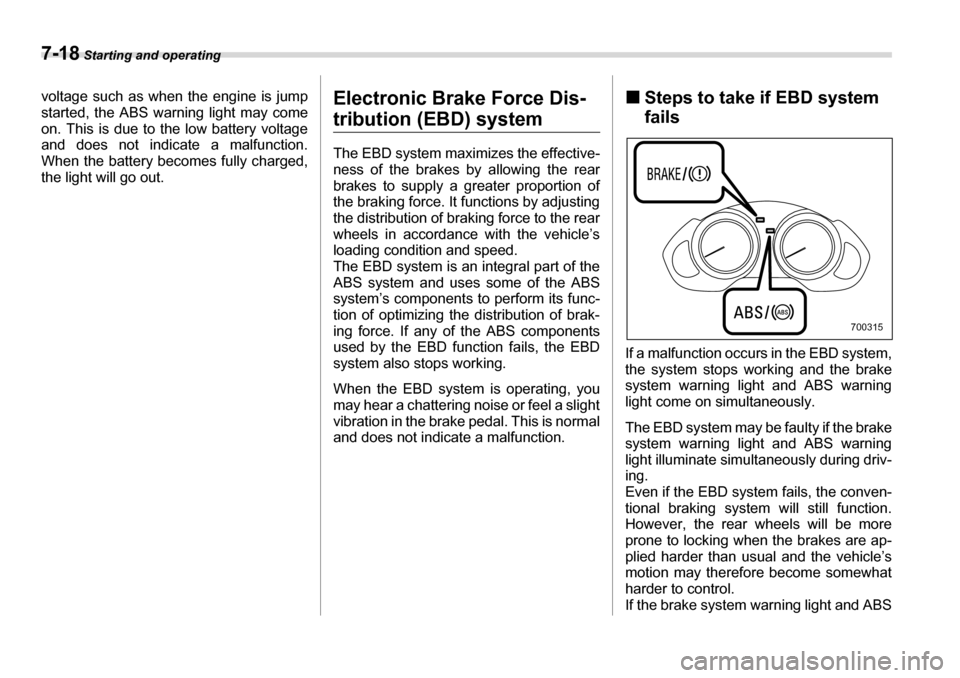
7-18 Starting and operating
voltage such as when the engine is jump started, the ABS warning light may come
on. This is due to the low battery voltage
and does not indicate a malfunction.
When the battery becomes fully charged,
the light will go out. Electronic Brake Force Dis-
tribution (EBD) system
The EBD system maximizes the effective-
ness of the brakes by allowing the rear
brakes to supply a greater proportion of
the braking force. It functions by adjusting
the distribution of braking force to the rear
wheels in accordance with the vehicle’s
loading condition and speed.
The EBD system is an integral part of the
ABS system and uses some of the ABS
system’s components to perform its func-
tion of optimizing the distribution of brak- ing force. If any of the ABS components
used by the EBD function fails, the EBD
system also stops working.
When the EBD system is operating, you
may hear a chattering noise or feel a slight
vibration in the brake pedal. This is normal
and does not indicate a malfunction.�„
Steps to take if EBD system
fails
If a malfunction occurs in the EBD system,
the system stops working and the brake
system warning light and ABS warning
light come on simultaneously.
The EBD system may be faulty if the brake
system warning light and ABS warning
light illuminate simultaneously during driv-
ing.
Even if the EBD system fails, the conven-
tional braking system will still function.
However, the rear wheels will be more
prone to locking when the brakes are ap-
plied harder than usual and the vehicle’s
motion may therefore become somewhat
harder to control. If the brake system warning light and ABS
700315